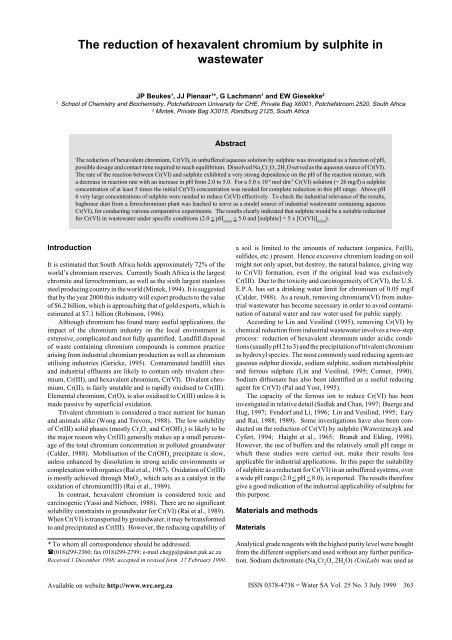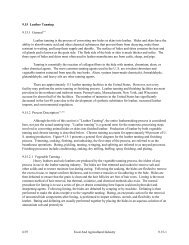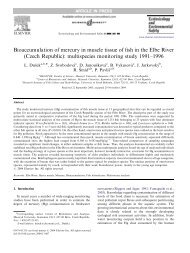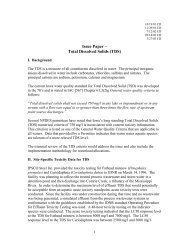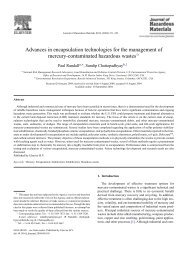The reduction of hexavalent chromium by sulphite in wastewater
The reduction of hexavalent chromium by sulphite in wastewater
The reduction of hexavalent chromium by sulphite in wastewater
Create successful ePaper yourself
Turn your PDF publications into a flip-book with our unique Google optimized e-Paper software.
Introduction<br />
<strong>The</strong> <strong>reduction</strong> <strong>of</strong> <strong>hexavalent</strong> <strong>chromium</strong> <strong>by</strong> <strong>sulphite</strong> <strong>in</strong><br />
<strong>wastewater</strong><br />
JP Beukes 1 , JJ Pienaar 1 *, G Lachmann 1 and EW Giesekke 2<br />
1 School <strong>of</strong> Chemistry and Biochemistry, Potchefstroom University for CHE, Private Bag X6001, Potchefstroom 2520, South Africa<br />
2 M<strong>in</strong>tek, Private Bag X3015, Randburg 2125, South Africa<br />
It is estimated that South Africa holds approximately 72% <strong>of</strong> the<br />
world’s <strong>chromium</strong> reserves. Currently South Africa is the largest<br />
chromite and ferro<strong>chromium</strong>, as well as the sixth largest sta<strong>in</strong>less<br />
steel produc<strong>in</strong>g country <strong>in</strong> the world (M<strong>in</strong>tek, 1994). It is suggested<br />
that <strong>by</strong> the year 2000 this <strong>in</strong>dustry will export products to the value<br />
<strong>of</strong> $6.2 billion, which is approach<strong>in</strong>g that <strong>of</strong> gold exports, which is<br />
estimated at $7.1 billion (Rob<strong>in</strong>son, 1996).<br />
Although <strong>chromium</strong> has found many useful applications, the<br />
impact <strong>of</strong> the <strong>chromium</strong> <strong>in</strong>dustry on the local environment is<br />
extensive, complicated and not fully quantified. Landfill disposal<br />
<strong>of</strong> waste conta<strong>in</strong><strong>in</strong>g <strong>chromium</strong> compounds is common practice<br />
aris<strong>in</strong>g from <strong>in</strong>dustrial <strong>chromium</strong> production as well as <strong>chromium</strong><br />
utilis<strong>in</strong>g <strong>in</strong>dustries (Gericke, 1995). Contam<strong>in</strong>ated landfill sites<br />
and <strong>in</strong>dustrial effluents are likely to conta<strong>in</strong> only trivalent <strong>chromium</strong>,<br />
Cr(III), and <strong>hexavalent</strong> <strong>chromium</strong>, Cr(VI). Divalent <strong>chromium</strong>,<br />
Cr(II), is fairly unstable and is rapidly oxidised to Cr(III).<br />
Elemental <strong>chromium</strong>, Cr(O), is also oxidised to Cr(III) unless it is<br />
made passive <strong>by</strong> superficial oxidation.<br />
Trivalent <strong>chromium</strong> is considered a trace nutrient for human<br />
and animals alike (Wong and Trevors, 1988). <strong>The</strong> low solubility<br />
<strong>of</strong> Cr(III) solid phases (mostly Cr 2 O 3 and Cr(OH) 3 ) is likely to be<br />
the major reason why Cr(III) generally makes up a small percentage<br />
<strong>of</strong> the total <strong>chromium</strong> concentration <strong>in</strong> polluted groundwater<br />
(Calder, 1988). Mobilisation <strong>of</strong> the Cr(OH) 3 precipitate is slow,<br />
unless enhanced <strong>by</strong> dissolution <strong>in</strong> strong acidic environments or<br />
complexation with organics (Rai et al., 1987). Oxidation <strong>of</strong> Cr(III)<br />
is mostly achieved through MnO 2 , which acts as a catalyst <strong>in</strong> the<br />
oxidation <strong>of</strong> <strong>chromium</strong>(III) (Rai et al., 1989).<br />
In contrast, <strong>hexavalent</strong> <strong>chromium</strong> is considered toxic and<br />
carc<strong>in</strong>ogenic (Yassi and Nieboer, 1988). <strong>The</strong>re are no significant<br />
solubility constra<strong>in</strong>ts <strong>in</strong> groundwater for Cr(VI) (Rai et al., 1989).<br />
When Cr(VI) is transported <strong>by</strong> groundwater, it may be transformed<br />
to and precipitated as Cr(III). However, the reduc<strong>in</strong>g capability <strong>of</strong><br />
Available on website http://www.wrc.org.za<br />
Abstract<br />
<strong>The</strong> <strong>reduction</strong> <strong>of</strong> <strong>hexavalent</strong> <strong>chromium</strong>, Cr(VI), <strong>in</strong> unbuffered aqueous solution <strong>by</strong> <strong>sulphite</strong> was <strong>in</strong>vestigated as a function <strong>of</strong> pH,<br />
possible dosage and contact time required to reach equilibrium. Dissolved Na 2 Cr 2 O 7 .2H 2 O served as the aqueous source <strong>of</strong> Cr(VI).<br />
<strong>The</strong> rate <strong>of</strong> the reaction between Cr(VI) and <strong>sulphite</strong> exhibited a very strong dependence on the pH <strong>of</strong> the reaction mixture, with<br />
a decrease <strong>in</strong> reaction rate with an <strong>in</strong>crease <strong>in</strong> pH from 2.0 to 5.0. For a 5.0 x 10 -4 mol·dm -3 Cr(VI) solution (~ 26 mg/l) a <strong>sulphite</strong><br />
concentration <strong>of</strong> at least 5 times the <strong>in</strong>itial Cr(VI) concentration was needed for complete <strong>reduction</strong> <strong>in</strong> this pH range. Above pH<br />
6 very large concentrations <strong>of</strong> <strong>sulphite</strong> were needed to reduce Cr(VI) effectively. To check the <strong>in</strong>dustrial relevance <strong>of</strong> the results,<br />
baghouse dust from a ferro<strong>chromium</strong> plant was leached to serve as a model source <strong>of</strong> <strong>in</strong>dustrial <strong>wastewater</strong> conta<strong>in</strong><strong>in</strong>g aqueous<br />
Cr(VI), for conduct<strong>in</strong>g various comparative experiments. <strong>The</strong> results clearly <strong>in</strong>dicated that <strong>sulphite</strong> would be a suitable reductant<br />
for Cr(VI) <strong>in</strong> <strong>wastewater</strong> under specific conditions (2.0 < pH <strong>in</strong>itial < 5.0 and [<strong>sulphite</strong>] = 5 x [Cr(VI)] <strong>in</strong>itial ).<br />
* To whom all correspondence should be addressed.<br />
((018)299-2360; fax (018)299-2799; e-mail chejjp@puknet.puk.ac.za<br />
Received 1 December 1998; accepted <strong>in</strong> revised form 17 February 1999.<br />
a soil is limited to the amounts <strong>of</strong> reductant (organics, Fe(II),<br />
sulfides, etc.) present. Hence excessive <strong>chromium</strong> load<strong>in</strong>g on soil<br />
might not only upset, but destroy, the natural balance, giv<strong>in</strong>g way<br />
to Cr(VI) formation, even if the orig<strong>in</strong>al load was exclusively<br />
Cr(III). Due to the toxicity and carc<strong>in</strong>ogenicity <strong>of</strong> Cr(VI), the U.S.<br />
E.P.A. has set a dr<strong>in</strong>k<strong>in</strong>g water limit for <strong>chromium</strong> <strong>of</strong> 0.05 mg/l<br />
(Calder, 1988). As a result, remov<strong>in</strong>g <strong>chromium</strong>(VI) from <strong>in</strong>dustrial<br />
<strong>wastewater</strong> has become necessary <strong>in</strong> order to avoid contam<strong>in</strong>ation<br />
<strong>of</strong> natural water and raw water used for public supply.<br />
Accord<strong>in</strong>g to L<strong>in</strong> and Vesil<strong>in</strong>d (1995), remov<strong>in</strong>g Cr(VI) <strong>by</strong><br />
chemical <strong>reduction</strong> from <strong>in</strong>dustrial <strong>wastewater</strong> <strong>in</strong>volves a two-step<br />
process: <strong>reduction</strong> <strong>of</strong> <strong>hexavalent</strong> <strong>chromium</strong> under acidic conditions<br />
(usually pH 2 to 3) and the precipitation <strong>of</strong> trivalent <strong>chromium</strong><br />
as hydroxyl species. <strong>The</strong> most commonly used reduc<strong>in</strong>g agents are<br />
gaseous sulphur dioxide, sodium <strong>sulphite</strong>, sodium metabi<strong>sulphite</strong><br />
and ferrous sulphate (L<strong>in</strong> and Vesil<strong>in</strong>d, 1995; Conner, 1990).<br />
Sodium dithionate has also been identified as a useful reduc<strong>in</strong>g<br />
agent for Cr(VI) (Pal and Yost, 1995).<br />
<strong>The</strong> capacity <strong>of</strong> the ferrous ion to reduce Cr(VI) has been<br />
<strong>in</strong>vestigated <strong>in</strong> relative detail (Sedlak and Chan, 1997; Buerge and<br />
Hug, 1997; Fendorf and Li, 1996; L<strong>in</strong> and Vesil<strong>in</strong>d, 1995; Eary<br />
and Rai, 1988; 1989). Some <strong>in</strong>vestigations have also been conducted<br />
on the <strong>reduction</strong> <strong>of</strong> Cr(VI) <strong>by</strong> <strong>sulphite</strong> (Wawrzenczyk and<br />
Cyfert, 1994; Haight et al., 1965; Brandt and Eld<strong>in</strong>g, 1998).<br />
However, the use <strong>of</strong> buffers and the relatively small pH range <strong>in</strong><br />
which these studies were carried out, make their results less<br />
applicable for <strong>in</strong>dustrial applications. In this paper the suitability<br />
<strong>of</strong> <strong>sulphite</strong> as a reductant for Cr(VI) <strong>in</strong> an unbuffered systems, over<br />
a wide pH range (2.0 < pH < 8.0), is reported. <strong>The</strong> results therefore<br />
give a good <strong>in</strong>dication <strong>of</strong> the <strong>in</strong>dustrial applicability <strong>of</strong> <strong>sulphite</strong> for<br />
this purpose.<br />
Materials and methods<br />
Materials<br />
Analytical grade reagents with the highest purity level were bought<br />
from the different suppliers and used without any further purification.<br />
Sodium dichromate (Na 2 Cr 2 O 7 .2H 2 O) (UniLab) was used as<br />
ISSN 0378-4738 = Water SA Vol. 25 No. 3 July 1999 363
the aqueous source <strong>of</strong> Cr(VI). Sodium <strong>sulphite</strong> (Na 2 SO 3 ) (Merck),<br />
and sodium metabi<strong>sulphite</strong> (Na 2 S 2 O 5 ) (BDH) were used as the<br />
<strong>sulphite</strong> sources. <strong>The</strong> pH <strong>of</strong> reactant solutions was adjusted prior<br />
to mix<strong>in</strong>g with stock solutions <strong>of</strong> sodium hydroxide (NaOH)<br />
(Merck) and/or perchloric acid (HClO 4 ) (BDH), the ionic strength<br />
<strong>of</strong> all solutions was kept constant at 0.1 mol·dm -3 <strong>by</strong> add<strong>in</strong>g<br />
calculated volumes <strong>of</strong> a stock solution <strong>of</strong> sodium perchlorate<br />
(NaClO 4 .H 2 O) (Merck) to the reactant solutions. Millipore milli-<br />
Q deionised water (18 MΩ·cm -1 ) was used to make up all solutions.<br />
Baghouse dust from a ferro<strong>chromium</strong> plant, leached with<br />
milli-Q water, served as a model source <strong>of</strong> <strong>in</strong>dustrial <strong>wastewater</strong><br />
conta<strong>in</strong><strong>in</strong>g aqueous Cr(VI). Dur<strong>in</strong>g the leach<strong>in</strong>g procedure 1 g <strong>of</strong><br />
baghouse dust and 10 ml <strong>of</strong> water was stirred for 15 m<strong>in</strong>. <strong>The</strong><br />
solution was thereafter filtered <strong>by</strong> us<strong>in</strong>g a nylon Millipore filter<br />
(0.2 µm pore size) and diluted as required.<br />
Methods<br />
A variety <strong>of</strong> analytical methods can be employed to determ<strong>in</strong>e the<br />
<strong>chromium</strong> concentration <strong>in</strong> aqueous solution (Vogel, 1989). <strong>The</strong><br />
most commonly used techniques are ion chromatography, atomic<br />
absorption and colorimetric methods, whereas titrimetric and gravimetric<br />
techniques have become less favourable s<strong>in</strong>ce they are<br />
tedious and less accurate at low concentrations. Due to its relative<br />
ease <strong>of</strong> use and the fact that concentration changes can be monitored<br />
as they take place, the direct photometric absorption measurement<br />
method was chosen as the standard procedure to monitor the<br />
aqueous concentration <strong>of</strong> Cr(VI).<br />
All k<strong>in</strong>etic experiments were carried out on a Pharmacia<br />
Biotech Ultrospec 3000 spectrophotometer or a SX-17MV Stopped-<br />
Flow spectrophotometer from Applied Photophysics. <strong>The</strong> temperature<br />
<strong>of</strong> all reagent mixtures was kept constant at 25.0° ± 0.5°C.<br />
<strong>The</strong> pH <strong>of</strong> the various reagents and reaction mixtures was measured<br />
with a Hanna Instruments (HI) 9318 pH meter, fitted with an HI<br />
1131 pH electrode and an HI 7669/2 temperature sensor.<br />
A limited number <strong>of</strong> atomic absorption (AA) determ<strong>in</strong>ations<br />
were done, to analyse aqueous solutions leached out <strong>of</strong> baghouse<br />
dust from a ferro<strong>chromium</strong> plant. For this purpose a Varian<br />
SpectAA-250 Plus spectrometer was used. Scann<strong>in</strong>g electron<br />
micrographs <strong>of</strong> the baghouse dust were obta<strong>in</strong>ed with a Cambridge<br />
Stereoscan 250 scann<strong>in</strong>g electron microscope, us<strong>in</strong>g carbon tape to<br />
bond the dust onto the metal mount<strong>in</strong>g plates.<br />
Results and discussion<br />
If SO 2 (g) is dissolved <strong>in</strong> water, the follow<strong>in</strong>g equilibria exist:<br />
SO 2 (g) + H 2 O SO 2 .H 2 O(aq) (1)<br />
SO .H O(aq) H 2 2 + - + HSO (2)<br />
3<br />
- + 2 - HSO H + SO3<br />
(3)<br />
3<br />
- 2 - 2HSO Gold<strong>in</strong>g dimer S O + H2O (4)<br />
3<br />
2 5<br />
with values <strong>of</strong> K hs = 1.24 mol·dm -3 ·atm -1 at 25°C and I = 1.0<br />
mol·dm -3 (Van Eldik and Harris, 1980), K s1 = 1.29 x 10 -2<br />
mol·dm -3 at 25°C (Maahs, 1982), K s2 = 6.014 x 10 -8 mol·dm -3 at<br />
25°C (Maahs, 1982) and K s3 = 7.6 x 10 -2 dm -3 ·mol -1 at 25°C (Bourne<br />
et al., 1974) reported <strong>in</strong> literature. <strong>The</strong>se equilibria and equilibria<br />
constants are also valid for aqueous <strong>sulphite</strong> or bi<strong>sulphite</strong> solutions.<br />
Independent <strong>of</strong> the source (dissolved SO 2 , <strong>sulphite</strong> or bi<strong>sulphite</strong>),<br />
the total concentration <strong>of</strong> dissolved sulphur <strong>in</strong> the 4+ oxidation state<br />
2 - is referred to as S(IV). S<strong>in</strong>ce concentrations <strong>of</strong> S O <strong>in</strong> dilute<br />
2 5<br />
aqueous solutions are very low, S(IV) can be def<strong>in</strong>ed as:<br />
[S(IV)] = [SO 2 .H 2 O(aq)] + [HSO 3<br />
- 2 - ] + [SO3 ] (5)<br />
In contrast to the term “<strong>sulphite</strong>”, “S(IV)” can be used <strong>in</strong> a more<br />
general sense, s<strong>in</strong>ce it does not depend on reaction conditions. In<br />
this paper all the results will therefore be discussed <strong>in</strong> terms <strong>of</strong><br />
S(IV) and not <strong>sulphite</strong>.<br />
Characteristics <strong>of</strong> Cr(VI)-S(IV) reaction system<br />
Cr(VI) has a strong UV/visible spectrum with a very large molar<br />
absorption coefficient <strong>of</strong> 1550 mol -1 ·dm -3 ·cm -1 at 350 nm (Wawrzenczyk<br />
and Cyfert, 1994). In comparison, the UV/visible spectrum<br />
<strong>of</strong> S(IV) is very weak with low <strong>in</strong>tensity absorption bands at short<br />
wavelengths (~260 nm), visible only at relatively low pH values<br />
(pH < 3). Cr(III), formed dur<strong>in</strong>g the <strong>reduction</strong> <strong>of</strong> Cr(VI) with S(IV),<br />
also exhibited a UV/visible spectrum, but with a relatively small<br />
molar absorption coefficient <strong>of</strong> 13.5 mol -1 ·dm -3 ·cm -1 at 350 nm<br />
(Wawrenczyk and Cyfert, 1994). K<strong>in</strong>etic experiments were therefore<br />
carried out at 350 and 370 nm where the absorption <strong>by</strong> S(IV)<br />
and Cr(III) is negligible.<br />
Effects <strong>of</strong> pH on Cr(VI) <strong>reduction</strong><br />
To determ<strong>in</strong>e the effect <strong>of</strong> pH on the <strong>reduction</strong> <strong>of</strong> Cr(VI) <strong>by</strong> S(IV),<br />
a 5.0 x 10 -4 mol·dm -3 Cr(VI) solution was treated with S(IV),<br />
rang<strong>in</strong>g <strong>in</strong> concentration from 5 to 15 times the <strong>in</strong>itial Cr(VI)<br />
concentration ([Cr(VI)] <strong>in</strong>itial ). To facilitate the comparison <strong>of</strong> results<br />
under different reaction conditions, results are given <strong>in</strong> terms <strong>of</strong> the<br />
percentage <strong>reduction</strong> <strong>of</strong> the [Cr(VI)] <strong>in</strong>itial vs. time required. As can<br />
be seen from Fig. 1, <strong>in</strong>itial pH <strong>of</strong> the reaction mixture has a strong<br />
and def<strong>in</strong>ite effect on <strong>reduction</strong> times. For 2.0 < pH <strong>in</strong>itial < 6.0, the<br />
time required to achieve 50% <strong>reduction</strong> <strong>of</strong> the [Cr(VI)] <strong>in</strong>itial (t 0.5 )<br />
<strong>in</strong>creased logarithmically with <strong>in</strong>creas<strong>in</strong>g pH <strong>in</strong>itial .<br />
Under the same reaction conditions the time required to achieve<br />
95% <strong>reduction</strong> <strong>of</strong> [Cr(VI)] <strong>in</strong>itial (t 0.95 ) showed a similar trend, <strong>in</strong>creas<strong>in</strong>g<br />
logarithmically with <strong>in</strong>creas<strong>in</strong>g pH, at 2.0 < pH <strong>in</strong>itial < 4.0<br />
(Fig. 2). A discont<strong>in</strong>uity is, however, observed at pH <strong>in</strong>itial > 4 where<br />
the time required to reach 95% <strong>reduction</strong>, is no longer directly<br />
logarithmically related to the pH <strong>in</strong>itial .<br />
At pH <strong>in</strong>itial > 6 very long reaction times, together with large<br />
S(IV) concentrations, were needed to reduce Cr(VI) successfully.<br />
For <strong>in</strong>stance at pH <strong>in</strong>itial = 7.0, with [S(IV)] = 15 x [Cr(VI)] <strong>in</strong>itial , it took<br />
7.4 h to reach a 50% <strong>reduction</strong> and 15.3 h to reach 95% <strong>reduction</strong><br />
<strong>of</strong> [Cr(VI)] <strong>in</strong>itial . At pH <strong>in</strong>itial = 8.0, with [S(IV)] = 50 x [Cr(VI)] <strong>in</strong>itial ,<br />
only 16% <strong>reduction</strong> <strong>of</strong> [Cr(VI)] <strong>in</strong>itial had occurred after 6 d. No<br />
further <strong>in</strong>vestigations <strong>in</strong>to the <strong>reduction</strong> <strong>of</strong> Cr(VI) <strong>by</strong> S(IV) were<br />
therefore conducted at pH <strong>in</strong>itial > 7.<br />
In order to correlate the above-mentioned results with published<br />
data, t 0.5 = 0.034 s was calculated from k obs = 20.3 s -1 reported<br />
<strong>by</strong> Wawrzenczyk and Cyfert (1994), at pH 1.46 and [S(IV)] = 10<br />
x 10 -3 mol·dm -3 . Extrapolation <strong>of</strong> experimental results ([S(IV)] =<br />
7.5 x 10 -3 mol·dm -3 ) to pH 1.46 yielded t 0.5 = 0.030 s.<br />
Look<strong>in</strong>g at the results shown <strong>in</strong> Figs. 1 and 2, three phenomena<br />
warrant explanation: a) what causes the reaction rate to <strong>in</strong>crease at<br />
lower pH values; b) why a logarithmical <strong>in</strong>crease <strong>in</strong> the time<br />
required to reach 50% <strong>reduction</strong> <strong>of</strong> [Cr(VI)] <strong>in</strong>itial was observed for<br />
<strong>in</strong>creas<strong>in</strong>g pH (2.0 < pH < 6.0); and c) why this logarithmic<br />
<strong>in</strong>crease only persisted between pH 2 and 4 for the time required to<br />
reach 95% <strong>reduction</strong> <strong>of</strong> the [Cr(VI)] <strong>in</strong>itial .<br />
364 ISSN 0378-4738 = Water SA Vol. 25 No. 3 July 1999<br />
Available on website http://www.wrc.org.za
log (t 0.5 / s)<br />
log (t 0.95 / s)<br />
4<br />
3<br />
2<br />
1<br />
0<br />
1 2 3 4 5 6 7<br />
-1<br />
-2<br />
Figure 1<br />
Time required to reach 50% <strong>reduction</strong> <strong>of</strong> the <strong>in</strong>itial<br />
[Cr(VI)] (t 0.5 )<br />
[Cr(VI)] <strong>in</strong>itial = 5.0 x 10 -4 mol·dm -3 ; [S(IV)] = 5, 10 and 15 x<br />
[Cr(VI)] <strong>in</strong>itial ; I = 0.1 mol·dm -3 ; T = 25.0 ± 0.5°C<br />
4<br />
3<br />
2<br />
1<br />
0<br />
15x<br />
10x<br />
5x<br />
15x<br />
10x<br />
5x<br />
Figure 2<br />
Time required to reach 95% <strong>reduction</strong> <strong>of</strong> the <strong>in</strong>itial<br />
[Cr(VI)] (t ) 0.95<br />
[Cr(VI)] = 5.0 x 10 <strong>in</strong>itial -4 mol·dm-3 ; [S(IV)] = 5, 10 and 15 x<br />
[Cr(VI)] ; I = 0.1 mol·dm <strong>in</strong>itial -3 -1<br />
pH<br />
; T = 25.0 ± 0.5°C<br />
a) In order to expla<strong>in</strong> the <strong>in</strong>crease <strong>in</strong> reaction rate with decreas<strong>in</strong>g<br />
pH, one needs to take <strong>in</strong>to account the speciation <strong>of</strong> both Cr(VI)<br />
and S(IV) under these conditions. <strong>The</strong> Eh-pH diagram shown<br />
<strong>in</strong> Fig. 3 (Rai et al., 1989) provides a generalised depiction <strong>of</strong><br />
the major aqueous <strong>chromium</strong> species and redox stabilities<br />
under conditions <strong>of</strong> chemical equilibrium. <strong>The</strong> dom<strong>in</strong>ant<br />
- 2 - Cr(VI) species are HCrO at pH 1-6 and CrO4 at pH > 6.<br />
4<br />
- Chromium(VI) also forms other species, such as HCr O and<br />
2 7<br />
2 - Cr O . However, their formation requires Cr(VI) concentra-<br />
2 7<br />
tions > 10-2 mol·dm-3 (Baes and Mesmer, 1976). <strong>The</strong> <strong>in</strong>crease<br />
<strong>in</strong> reaction rate with decreas<strong>in</strong>g pH can therefore probably be<br />
- 2 -<br />
attributed to HCrO which is reduced more easily than CrO4<br />
4<br />
(see redox stabilities Fig. 3). By look<strong>in</strong>g at the speciation <strong>of</strong><br />
S(IV) (shown <strong>in</strong> Fig. 4) it is also quite apparent that the <strong>in</strong>crease<br />
<strong>in</strong> reaction rate with decreas<strong>in</strong>g pH, observed for the Cr(VI)-<br />
S(IV) reaction, correlates with the <strong>in</strong>crease <strong>in</strong> concentration <strong>of</strong><br />
SO .H O(aq) at lower pH values. <strong>The</strong> possibility that<br />
2 2<br />
pH<br />
1 2 3 4 5 6 7<br />
Available on website http://www.wrc.org.za<br />
E h / V<br />
Fraction <strong>of</strong> S(IV)<br />
1.2<br />
0.8<br />
0.4<br />
0<br />
-0.4<br />
-0.8<br />
Figure 3<br />
Eh-pH diagram for aqueous <strong>chromium</strong> species<br />
(Rai et al., 1989)<br />
1<br />
0.8<br />
0.6<br />
0.4<br />
0.2<br />
0<br />
SO2.H2O<br />
0 2 4 6 8 10<br />
pH<br />
SO .H O(aq) might be the most reactive S(IV) species <strong>in</strong> this<br />
2 2<br />
process must therefore also not be overlooked. In fact Haight<br />
et al. (1965) postulated a reaction mechanism for the <strong>reduction</strong><br />
<strong>of</strong> Cr(VI) <strong>by</strong> S(IV) <strong>in</strong> which SO .H O(aq) took part <strong>in</strong> the rate-<br />
2 2<br />
determ<strong>in</strong><strong>in</strong>g step, while Wawrzenczyk and Cyfert (1994) sug-<br />
- gested that both SO .H O(aq) and HSO took part <strong>in</strong> two<br />
2 2 3<br />
separate rate-determ<strong>in</strong><strong>in</strong>g steps. This can, however, not be<br />
used as conclusive evidence for the reactivity patterns <strong>of</strong> S(IV),<br />
s<strong>in</strong>ce both <strong>of</strong> these studies were conducted over a very small pH<br />
range at low pH values.<br />
b) A logarithmic <strong>in</strong>crease <strong>in</strong> time required to reach a certa<strong>in</strong><br />
percentage <strong>reduction</strong> <strong>of</strong> the [Cr(VI)] , for <strong>in</strong>creas<strong>in</strong>g pH, can<br />
<strong>in</strong>itial<br />
be expla<strong>in</strong>ed if the Cr(VI)-S(IV) reaction system’s rate law has<br />
a first-order dependence on the [H + ]. For example a simple rate<br />
law might be:<br />
-d[Cr(VI]<br />
dt<br />
Cr 3+<br />
CrOH 2+<br />
This can be simplified to:<br />
-<br />
HCrO4 HSO3 -<br />
0<br />
Cr(OH) 3<br />
2-<br />
CrO4 SO3 2-<br />
-<br />
Cr(OH) 4<br />
0 2 4 6 8 10 12 14<br />
Figure 4<br />
Distribution curve <strong>of</strong> different S(IV) species as a function<br />
<strong>of</strong> pH, at concentrations relevant to this <strong>in</strong>vestigation<br />
(~ 10 -3 mol·dm -3 )<br />
pH<br />
= k[H + ][Cr(VI)][S(IV)] (6)<br />
ISSN 0378-4738 = Water SA Vol. 25 No. 3 July 1999 365
-d[Cr(VI] = k’[Cr(VI)] (7)<br />
dt<br />
with k’ = k[H + ][S(IV)] (8)<br />
<strong>The</strong> half life, t 0.5 , for a first-order reaction is given <strong>by</strong>:<br />
ln2<br />
t 0.5 = (9)<br />
k’<br />
Which means that:<br />
1<br />
t 0.5 ∝ , s<strong>in</strong>ce k’ ∝ [H + ] (10)<br />
[H + ]<br />
<strong>The</strong>refore:<br />
1<br />
log (t ) ∝ log ( ) = pH (11)<br />
0.5<br />
[H + ]<br />
In the same way log (t 0.95 ) ∝ pH. <strong>The</strong> logarithmic <strong>in</strong>crease <strong>in</strong><br />
time required to reach a 50% <strong>reduction</strong> <strong>of</strong> the [Cr(VI)] <strong>in</strong>itial , for<br />
<strong>in</strong>creas<strong>in</strong>g pH, can therefore be expla<strong>in</strong>ed <strong>by</strong> the fact that the<br />
Cr(VI)-S(IV) reaction system’s rate law has a first order<br />
dependence on the [H + ]. As long as the pH rema<strong>in</strong>s constant,<br />
this direct relationship will rema<strong>in</strong>.<br />
c) Dur<strong>in</strong>g this <strong>in</strong>vestigation, unbuffered reaction mixtures were<br />
used. Any drift <strong>in</strong> pH, due to the formation <strong>of</strong> reaction products,<br />
would obviously <strong>in</strong>fluence the <strong>reduction</strong> rate. To <strong>in</strong>vestigate<br />
this possibility, some <strong>in</strong>itial and f<strong>in</strong>al pH values, at a fixed<br />
[Cr(VI)] <strong>in</strong>itial and [S(VI)], were measured (Table 1). From these<br />
results it is clear that there is a slightly upward drift <strong>in</strong> pH at<br />
2.0 < pH <strong>in</strong>itial < 4.0, which is due to the consumption <strong>of</strong> H + ions<br />
(see Reactions 12 and 13 <strong>in</strong> the next section). At pH <strong>in</strong>itial > 4 a<br />
downwards drift <strong>in</strong> pH was observed. <strong>The</strong> amount <strong>of</strong> pH drift<br />
also becomes significantly larger as the <strong>in</strong>itial pH <strong>in</strong>crease from<br />
4 to 7. A feasible explanation for this depression <strong>in</strong> pH at higher<br />
<strong>in</strong>itial pH values is the release <strong>of</strong> H + ions due to hydrolysis <strong>of</strong><br />
the Cr(III) ions produced <strong>by</strong> the reaction, which dom<strong>in</strong>ates the<br />
consumption <strong>of</strong> H + ions <strong>by</strong> reactions 12 and 13. Above pH<br />
= 5, hydrolysis <strong>of</strong> the Cr(III) ions become significant (Richard<br />
and Bourg, 1991). <strong>The</strong> effect <strong>of</strong> pH drift on the reaction is also<br />
reflected <strong>by</strong> the shapes <strong>of</strong> the k<strong>in</strong>etic traces at different pH<br />
values. At pH <strong>in</strong>itial = 5.0, where the pH drift was relatively small,<br />
typical first-order-like time traces were observed (see Fig. 5a).<br />
<strong>The</strong> time traces observed at pH <strong>in</strong>itial = 7.0 exhibited a shape<br />
generally associated with autocatalytical processes (see Fig.<br />
5b) - at first the reaction rate is slow, it then accelerates either<br />
<strong>by</strong> the formation <strong>of</strong> a species which accelerates the reaction rate<br />
or <strong>by</strong> the consumption <strong>of</strong> species which retards the reaction and<br />
eventually the reaction rate slows down aga<strong>in</strong> due to the<br />
depletion <strong>of</strong> one or more <strong>of</strong> the reagents. Indeed, the unbuffered<br />
<strong>reduction</strong> <strong>of</strong> aqueous Cr(VI) <strong>by</strong> S(IV), at pH <strong>in</strong>itial > 4, can be seen<br />
as an autocatalytic process. <strong>The</strong> k<strong>in</strong>etic trace <strong>in</strong> Fig. 5b can be<br />
expla<strong>in</strong>ed as follows: <strong>in</strong>itially the reaction rate is slow, then as<br />
<strong>reduction</strong> starts tak<strong>in</strong>g place the pH starts drift<strong>in</strong>g down which<br />
accelerates the <strong>reduction</strong> rate and eventually the <strong>reduction</strong> rate<br />
slows down due to the depletion <strong>of</strong> Cr(VI). In the previous<br />
paragraph it was shown that log (t 0.95 ) ∝ pH, if the pH rema<strong>in</strong>s<br />
constant. <strong>The</strong> fact that a significant downwards drift <strong>in</strong> pH was<br />
observed at pH <strong>in</strong>itial > 4, means that the direct relationship<br />
between log (t 0.95 ) and pH is no longer valid, expla<strong>in</strong><strong>in</strong>g the<br />
discont<strong>in</strong>uity at pH > 4 <strong>in</strong> Fig. 2.<br />
TABLE 1<br />
A COMPARISON BETWEEN INITIAL<br />
AND FINAL pH VALUES FOR THE<br />
REDUCTION OF Cr(VI) BY S(IV) IN<br />
UNBUFFERED SOLUTIONS<br />
[Cr(VI)] INITIAL = 5.0 x 10 -4 mol·dm -3 ;<br />
[S(IV)] = 15 x [Cr(VI)] INITIAL ;<br />
I = 0.1 mol·dm -3 ;<br />
T = 25.0 ± 0.5°C<br />
Initial pH F<strong>in</strong>al pH<br />
2.0 ± 0.1 2.1 ± 0.1<br />
3.0 ± 0.1 3.6 ± 0.2<br />
4.0 ± 0.1 4.0 ± 0.1<br />
5.0 ± 0.1 4.4 ± 0.3<br />
6.0 ± 0.1 4.5 ± 0.3<br />
7.0 ± 0.1 4.3 ± 0.3<br />
366 ISSN 0378-4738 = Water SA Vol. 25 No. 3 July 1999<br />
Available on website http://www.wrc.org.za<br />
a<br />
10 4 [Cr(VI)] / mol.dm -3<br />
b<br />
10 4 [Cr(VI)] / mol.dm -3<br />
6<br />
5<br />
4<br />
3<br />
2<br />
1<br />
0<br />
6<br />
5<br />
4<br />
3<br />
2<br />
1<br />
0<br />
pH = 5.0<br />
pH = 4.4<br />
0 100 200 300 400 500<br />
Time / s<br />
pH = 7.0<br />
pH = 4.3<br />
0 5 10 15 20 25<br />
Time / h<br />
Figure 5<br />
K<strong>in</strong>etic traces for the <strong>reduction</strong> <strong>of</strong> Cr(VI) <strong>by</strong> S(VI)<br />
[Cr(VI)] <strong>in</strong>itial = 5.0 x 10 -4 mol·dm -3 ; [S(IV)] = 15 x<br />
[Cr(VI)] <strong>in</strong>itial ; I = 0.1 mol·dm -3 ; T = 25.0 ± 0.5°C<br />
a: pH <strong>in</strong>itial = 5.0 ± 0.1<br />
b: pH <strong>in</strong>itial = 7.0 ± 0.1
Required dosage <strong>of</strong> [S(IV)]<br />
As was shown <strong>in</strong> the previous section, <strong>in</strong>itial<br />
pH <strong>of</strong> the reaction mixture is <strong>of</strong> great importance<br />
for effective <strong>reduction</strong> <strong>of</strong> aqueous Cr(VI)<br />
<strong>by</strong> S(IV). For the sake <strong>of</strong> practicality, the<br />
required dosage <strong>of</strong> S(IV) to ensure complete<br />
<strong>reduction</strong> <strong>of</strong> [Cr(VI)] <strong>in</strong>itial was firstly <strong>in</strong>vestigated<br />
at the optimum pH <strong>in</strong>itial .<br />
<strong>The</strong> optimum pH for Cr(VI) <strong>reduction</strong>, <strong>by</strong><br />
S(IV), seems to be at low pH values - <strong>in</strong> fact the<br />
lower the pH <strong>in</strong>itial , the faster the <strong>reduction</strong> process<br />
(see Figs. 1 and 2). But to assume that<br />
pH <strong>in</strong>itial = 2 (or even lower pH values) would be<br />
the optimum pH for <strong>in</strong>dustrial application might<br />
be wrong. From the distribution curve <strong>of</strong> the<br />
different S(IV) species (Fig. 4) it is clear that<br />
the largest changes <strong>in</strong> speciation occur between pH 0 and 4, where<br />
SO 2 .H 2 O(aq) decreases from approximately 99% to less than 1% <strong>of</strong><br />
the total S(IV) concentration. Between pH 1 and 3, SO 2 .H 2 O(aq)<br />
concentration changes form approximately 87% to 7% <strong>of</strong> the total<br />
S(IV) concentration. Tak<strong>in</strong>g <strong>in</strong>to account that SO 2 .H 2 O(aq) is <strong>in</strong><br />
equilibrium with SO 2 (g), it might be contra-productive to perform<br />
<strong>reduction</strong> <strong>of</strong> Cr(VI) <strong>by</strong> S(IV) at very low pH values, s<strong>in</strong>ce S(IV)<br />
would be lost to the atmosphere <strong>in</strong> the form <strong>of</strong> SO 2 (g). At pH = 3.0,<br />
the SO 2 .H 2 O(aq) component is only 7% <strong>of</strong> the total S(IV) concentration<br />
and was therefore chosen as an appropriate pH to <strong>in</strong>vestigate<br />
the required dosage <strong>of</strong> S(IV).<br />
Haight et al. (1965) as well as Wawrzenczyk and Cyfert (1994)<br />
expla<strong>in</strong>ed the stoichiometry <strong>of</strong> the reaction <strong>of</strong> Cr(VI) with S(IV) <strong>in</strong><br />
terms <strong>of</strong> the competition between two over-all reactions:<br />
- - + 2HCrO + 4HSO3 + 6H → 2Cr 4<br />
3+ 2- 2- + 2SO + S2O + 6H2O (12)<br />
4<br />
6<br />
- - + 2HCrO + 3HSO3 + 5H → 2Cr 4<br />
3+ 2- + 3SO + 5H2O (13)<br />
4<br />
An excess <strong>of</strong> S(IV) favours reaction (12), while an excess <strong>of</strong> Cr(VI)<br />
favours reaction (13). Accord<strong>in</strong>g to reactions (12) and (13), a S(IV)<br />
concentration <strong>of</strong> 1.5 to 2 times the [Cr(VI)] <strong>in</strong>itial would be sufficient<br />
to ensure complete <strong>reduction</strong> <strong>of</strong> Cr(VI). <strong>The</strong> practicality <strong>of</strong> this<br />
assumption is, however, poor. Table 2 gives an <strong>in</strong>dication <strong>of</strong><br />
[S(IV)] required for effective <strong>reduction</strong> <strong>of</strong> aqueous Cr(VI). When<br />
[S(IV)] was 3 or 4 x [Cr(VI)] <strong>in</strong>itial a 95% <strong>reduction</strong> <strong>of</strong> Cr(VI) was not<br />
obta<strong>in</strong>ed. A [S(IV)] <strong>of</strong> at least 5 x [Cr(VI)] <strong>in</strong>itial was required to<br />
reduce the aqueous Cr(VI) beyond a level <strong>of</strong> 95%. It furthermore<br />
follows from Fig. 2 that this S(IV) dosage would also be effective<br />
at 2.0 < pH <strong>in</strong>itial < 5.0.<br />
Industrial relevance <strong>of</strong> results<br />
All the results presented thus far were obta<strong>in</strong>ed us<strong>in</strong>g Na 2 Cr 2 O 7 .2H 2 O<br />
as the aqueous source <strong>of</strong> Cr(VI). To <strong>in</strong>vestigate the <strong>in</strong>dustrial<br />
relevance <strong>of</strong> these results, baghouse dust from a ferro<strong>chromium</strong><br />
plant was leached to serve as a model source <strong>of</strong> <strong>in</strong>dustrial <strong>wastewater</strong><br />
conta<strong>in</strong><strong>in</strong>g aqueous Cr(VI). This leached solutions was diluted, as<br />
required and treated with S(IV) under identical experimental<br />
conditions to make comparison <strong>of</strong> results possible.<br />
In order to draw any conclusions from the results, it was<br />
important to characterise the baghouse dust used to prepare the<br />
Cr(VI) solutions, so that possible differences <strong>in</strong> the k<strong>in</strong>etic behaviour<br />
could be expla<strong>in</strong>ed. A scan electron microscope (SEM)<br />
photograph <strong>of</strong> 11 177 times magnification (Fig. 6) showed that the<br />
baghouse dust consisted <strong>of</strong> small rounded particles, <strong>in</strong>dicat<strong>in</strong>g that<br />
Available on website http://www.wrc.org.za<br />
TABLE 2<br />
INFLUENCE OF [S(IV)] ON THE TIME REQUIRED TO REACH 50% AND<br />
95% REDUCTION OF [Cr(VI)] INITIAL<br />
[Cr(VI)] INITIAL = 5.0 x 10 -4 mol·dm -3 ; [S(IV)] = 3, 4, 5, 10 OR 15 x [Cr(VI)] INITIAL ;<br />
pH INITIAL = 3.0 ± 0.1; I = 0.1 mol·dm -3 ; T = 25.0 ± 0.5°C<br />
[S(IV)] Excess S(IV) Time to reach 50% Time to reach 95%<br />
/mol·dm -3 x 10 -3 <strong>reduction</strong>/s <strong>reduction</strong>/s<br />
1.5 3 25.0 ± 2.5 -<br />
2.0 4 18.0 ± 2.0 -<br />
2.5 5 3.0 ± 0.3 112.0 ± 10.0<br />
5.0 10 0.6 ± 0.04 11.0 ± 0.9<br />
7.5 15 0.3 ± 0.02 2.8 ± 0.2<br />
Figure 6<br />
SEM photograph <strong>of</strong> baghouse dust from a ferro<strong>chromium</strong><br />
plant at 11 177 time magnification<br />
melt<strong>in</strong>g had taken place. No unreacted chromite was observed (as<br />
would have been <strong>in</strong>dicated <strong>by</strong> uneven-shaped particles). SEM-<br />
EDAX elemental analyses <strong>of</strong> the baghouse dust (the presence <strong>of</strong><br />
oxygen and carbon were ignored) showed a relatively high percentage<br />
(i.e. 3.12%) <strong>of</strong> <strong>chromium</strong>. <strong>The</strong> numerical values <strong>of</strong> the SEM-<br />
EDAX elemental analyses are given <strong>in</strong> Table 3. Of particular<br />
<strong>in</strong>terest <strong>in</strong> this table are the presence <strong>of</strong> significant amounts <strong>of</strong> iron,<br />
s<strong>in</strong>ce it is well known that Fe(III) will catalyse the oxidation <strong>of</strong><br />
S(IV) <strong>by</strong> oxygen (Brandt and Van Eldik, 1995). If Fe(III) is present<br />
<strong>in</strong> the leached solutions, it will compete with Cr(VI) for the<br />
oxidation <strong>of</strong> S(IV), which will impact negatively on the <strong>reduction</strong><br />
<strong>of</strong> Cr(VI).<br />
S<strong>in</strong>ce the direct photometric absorption method was chosen as<br />
the standard procedure with which the aqueous concentration <strong>of</strong><br />
Cr(VI) was monitored, the validity <strong>of</strong> this method for the accurate<br />
determ<strong>in</strong>ation <strong>of</strong> the Cr(VI) concentrations <strong>in</strong> the leached solutions<br />
needed to be evaluated. To determ<strong>in</strong>e if there were any <strong>in</strong>terfer<strong>in</strong>g<br />
absorption peaks <strong>in</strong> the UV/visible spectra, the pH <strong>of</strong> both a leached<br />
solution, as well as a 5.0 x 10 -4 mol·dm -3 Cr(VI) solution<br />
(Na 2 Cr 2 O 7 .2H 2 O dissolved <strong>in</strong> milli-Q deionised water) were adjusted<br />
to pH 6.0 and the UV/visible spectra recorded separately.<br />
<strong>The</strong> molar absorption coefficients <strong>of</strong> the 5.0 x 10 -4 mol·dm -3 Cr(VI)<br />
solution was calculated at <strong>in</strong>tervals <strong>of</strong> 0.5 nm for λ = 330 to 480 nm.<br />
By us<strong>in</strong>g this data, a calculated Cr(VI) spectrum <strong>of</strong> any concentra-<br />
ISSN 0378-4738 = Water SA Vol. 25 No. 3 July 1999 367
Absorbance<br />
2<br />
1.5<br />
1<br />
0.5<br />
0<br />
TABLE 3<br />
SEM-EDAX ELEMENTAL ANALYSES OF<br />
THE BAGHOUSE DUST USED IN THIS STUDY.<br />
NUMERICAL VALUES ARE GIVEN IN TERMS OF<br />
THE PERCENTAGE WEIGHT, AS WELL AS THE<br />
PERCENTAGE ATOMIC WEIGHT FOR EACH<br />
ELEMENT, AS A FUNCTION OF ALL THE<br />
ELEMENTS DETECTED (NOTE THAT THE<br />
PRESENCE OF CARBON AND OXYGEN WERE<br />
IGNORED DURING THESE DETERMINATIONS)<br />
Element Wt% At%<br />
Na 13.58 18.28<br />
Mg 12.90 16.42<br />
Al 6.74 7.73<br />
Si 32.12 35.39<br />
P 1.08 1.08<br />
S 4.17 4.02<br />
Cl 1.21 1.06<br />
K 6.26 4.96<br />
Cr 3.12 1.86<br />
Fe 3.41 1.89<br />
Cu 1.11 0.54<br />
Zn 14.30 6.77<br />
Total 100.00 100.00<br />
Sodium dichromate<br />
Leached<br />
Calculated<br />
330 360 390 420 450 480<br />
Wavelength / nm<br />
Figure 7<br />
Comparison <strong>of</strong> the UV/visible spectra <strong>of</strong> Cr(VI) obta<strong>in</strong>ed <strong>by</strong> us<strong>in</strong>g<br />
Na 2 Cr 2 O 7 .H 2 O and baghouse dust from a ferro<strong>chromium</strong> plant<br />
tion could be constructed. Figure 7 shows that a Cr(VI) spectra<br />
could be calculated which corresponded almost perfectly with the<br />
spectrum <strong>of</strong> the leached solution. <strong>The</strong> residual spectrum (spectrum<br />
<strong>of</strong> leached solution m<strong>in</strong>us calculated spectrum) was almost negligible,<br />
<strong>in</strong>dicat<strong>in</strong>g that no absorption peaks <strong>of</strong> other species occurred.<br />
<strong>The</strong> same direct photometric absorption method used previously<br />
could therefore also be used for experiments with the leached<br />
solutions.<br />
A number <strong>of</strong> comparative experiments were conducted.<br />
Firstly, a leached solution was diluted so that a Cr(VI) solution with<br />
a concentration <strong>of</strong> 5.0 x 10 -4 mol·dm -3 was obta<strong>in</strong>ed. This solution<br />
was treated with the m<strong>in</strong>imum required S(IV) concentration (5 x<br />
[Cr(VI)] <strong>in</strong>itial ) and with<strong>in</strong> the effective pH range (2.0 < pH <strong>in</strong>itial < 5.0)<br />
as determ<strong>in</strong>ed <strong>in</strong> previous experiments. A comparison <strong>of</strong> <strong>reduction</strong><br />
times observed when Na 2 Cr 2 O 7 .2H 2 O and the leached solutions<br />
were respectively used as the aqueous sources <strong>of</strong> Cr(VI) is shown<br />
<strong>in</strong> Table 4. <strong>The</strong> results correlated almost perfectly. Surpris<strong>in</strong>gly no<br />
<strong>in</strong>terference <strong>by</strong> other species present <strong>in</strong> the leached solutions was<br />
observed. If for <strong>in</strong>stance any Fe(III) was present, it would have<br />
<strong>in</strong>fluenced the <strong>reduction</strong> process <strong>by</strong> catalys<strong>in</strong>g the oxidation <strong>of</strong><br />
S(IV). Atomic absorption (AA) measurements also confirmed that<br />
iron concentrations <strong>in</strong> the leached solutions were negligible.<br />
To further facilitate the evaluation <strong>of</strong> S(IV) as reduc<strong>in</strong>g agent<br />
for Cr(VI), a comparison with other reduc<strong>in</strong>g agents is necessary.<br />
A large number <strong>of</strong> chemical reduc<strong>in</strong>g agents exist for Cr(VI). Of<br />
those, Fe(II) is probably the most important s<strong>in</strong>ce it is used<br />
extensively for Cr(VI) <strong>reduction</strong> <strong>in</strong> <strong>wastewater</strong> <strong>of</strong> baghouse and/or<br />
scrubber dust <strong>by</strong> the ferro<strong>chromium</strong> <strong>in</strong>dustry (Gericke, 1995).<br />
Although Buerge and Hug (1997), as well as Sedlak and Chan<br />
(1997), conducted very detailed <strong>in</strong>vestigations on the <strong>reduction</strong> <strong>of</strong><br />
Cr(VI) <strong>by</strong> Fe(II), their results were made less comparable to the<br />
experimental results due to the fact that buffers were used. Fendorf<br />
and Li (1996), on the other hand, only <strong>in</strong>vestigated the <strong>reduction</strong><br />
process over a narrow pH range <strong>of</strong> 6.0 to 8.0. Table 5 shows a<br />
comparison between optimum parameters found experimentally<br />
for the Cr(VI)-S(IV) system and those reported for the Cr(VI)-<br />
Fe(II) system (Eary and Rai, 1988; L<strong>in</strong> and Vesil<strong>in</strong>d, 1995 and<br />
Gericke, 1995). From these data it is clear that Fe(II) can be used<br />
to reduce Cr(VI) from pH 2.0 up to at least pH 8.0. S(IV) on the<br />
other hand is only effective from pH 2.0 to 5.0. <strong>The</strong> effective<br />
dosage required for S(IV) is [S(IV)] = 5.0 x [Cr(VI)] <strong>in</strong>itial dosage,<br />
while that <strong>of</strong> Fe(II) is <strong>in</strong> the order <strong>of</strong> [Fe(II)] = 3.5 to 4 x [Cr(VI)] <strong>in</strong>itial .<br />
Direct comparison <strong>of</strong> the contact time required to reach a certa<strong>in</strong><br />
percentage Cr(VI) <strong>reduction</strong> <strong>by</strong> the two different reduc<strong>in</strong>g agents<br />
is, however, difficult due to the fundamental differences <strong>in</strong> the<br />
monitor<strong>in</strong>g techniques employed. <strong>The</strong> DPC (diphenylcarbazide)<br />
colorimetric method used to measure Cr(VI) concentration for the<br />
Fe(II)-Cr(VI) system is a batch method, which does not allow<br />
TABLE 4<br />
A COMPARISON OF REDUCTION TIMES USING Na 2 Cr 2 O 7 .H 2 O AND THE BAGHOUSE DUST FROM<br />
A FERROCHROMIUM PLANT, AS THE RESPECTIVE AQUEOUS SOURCES OF Cr(VI)<br />
[Cr(VI)] INITIAL = 5.0 x 10 -4 mol·dm -3 ; [S(IV)] = 5 x [Cr(VI)] INITIAL ; I = 0.1 mol·dm -3 ; T = 25.0 ± 0.5°C<br />
Sodium dichromate Baghouse dust<br />
pH Time required for Time required for Time required for Time required for<br />
50% <strong>reduction</strong>/s 95% <strong>reduction</strong>/s 50% <strong>reduction</strong>/s 95% <strong>reduction</strong>/s<br />
2.0 0.88 ± 0.06 7.8 ± 0.8 0.80 ± 0.07 7.9 ± 0.8<br />
3.0 3.0 ± 0.3 112 ± 9 3.2 ± 0.3 100 ± 8<br />
4.0 31.6 ± 2.9 1 258 ± 80 30.0 ± 2.8 1 122 ± 91<br />
5.0 220 ± 20 2 040 ± 110 200 ± 18 2 043 ± 115<br />
368 ISSN 0378-4738 = Water SA Vol. 25 No. 3 July 1999<br />
Available on website http://www.wrc.org.za
TABLE 5<br />
COMPARISON OF REDUCING CAPABILITY OF S(IV) (FOUND EXPERIMENTALLY) WITH THAT REPORTED FOR Fe(II)<br />
Reference Cr(VI) source Fe(II) or S(IV) source Effective Effective Fe(II)<br />
pH range dosage<br />
Experimental Na 2 Cr 2 O 7 or leached bahouse dust Na 2 SO 3 at pH > 6 and Na 2 S 2 O 5 at pH 5.<br />
Conclusions<br />
From the results presented the follow<strong>in</strong>g conclusions can be drawn:<br />
<strong>The</strong> pH <strong>of</strong> the reaction mixture has a strong effect on the<br />
<strong>reduction</strong> rate <strong>of</strong> Cr(VI) <strong>by</strong> S(IV).<br />
Dur<strong>in</strong>g the unbuffered <strong>reduction</strong> <strong>of</strong> Cr(VI) <strong>by</strong> S(IV), pH drift<br />
takes place, which <strong>in</strong>fluences the <strong>reduction</strong> process.<br />
Fast and complete <strong>reduction</strong> <strong>of</strong> Cr(VI) is favoured <strong>by</strong> low<br />
pH <strong>in</strong>itial (2.0 < pH <strong>in</strong>itial < 5.0).<br />
At pH <strong>in</strong>itial > 6 a very large excess <strong>of</strong> S(IV) is required for the<br />
effective <strong>reduction</strong> <strong>of</strong> Cr(VI).<br />
<strong>The</strong> concentration <strong>of</strong> S(IV) required for effective <strong>reduction</strong> <strong>of</strong><br />
Cr(VI) seems to be <strong>in</strong> the order <strong>of</strong> [S(IV)] = 5 x [Cr(VI)] <strong>in</strong>itial for<br />
2.0 < pH <strong>in</strong>itial < 5.0.<br />
An excellent correlation between results obta<strong>in</strong>ed us<strong>in</strong>g<br />
Na 2 Cr 2 O 7 .2H 2 O as the aqueous source <strong>of</strong> Cr(VI) and baghouse<br />
dust from a ferro<strong>chromium</strong> plant leached with milli-Q water<br />
was found. This correlation showed that the results obta<strong>in</strong>ed<br />
<strong>in</strong>dicate optimum conditions for <strong>in</strong>dustrial application.<br />
<strong>The</strong> required dosage for effective <strong>reduction</strong> <strong>of</strong> Cr(VI) <strong>by</strong> S(IV)<br />
compare favourably with the dosage required for Cr(VI) <strong>reduction</strong><br />
<strong>by</strong> Fe(II). <strong>The</strong> Fe(II) system is however effective over a<br />
larger pH range (see Table 5).<br />
Acknowledgements<br />
<strong>The</strong> authors gratefully acknowledge MINTEK, the FRD, ESKOM<br />
and THRIP for f<strong>in</strong>ancial support.<br />
References<br />
BAES CF and MESMER RE (1976) <strong>The</strong> Hydrolysis <strong>of</strong> Cations. Oak<br />
Ridge National Laboratory, New York, NY: Wiley. 489 pp.<br />
BARTLETT RJ (1991) Chromium cycl<strong>in</strong>g <strong>in</strong> soils and water: L<strong>in</strong>ks, gaps<br />
and methods. Environ. Health Perspective 92 17-24.<br />
BRANDT C and ELDING LI (1998) Role <strong>of</strong> <strong>chromium</strong> and vanadium<br />
<strong>in</strong> the atmospheric oxidation <strong>of</strong> sulfur(IV). Atmos. Environ. 32(4)<br />
797-800.<br />
BRANDT C and VAN ELDIK R (1995) Transition metal-catalysed<br />
oxidation <strong>of</strong> sulfur(IV) oxides. Atmospheric-relevant processes and<br />
mechanisms. Chem. Rev. 95 (1) 119-190.<br />
Available on website http://www.wrc.org.za<br />
BOURNE DWA, HIGUCHI T and PITMAN IA (1974) Chemical equilibria<br />
<strong>in</strong> solutions <strong>of</strong> bisulfite salts. J. Phar. Sci. 63 865-869.<br />
BUERGE IJ and HUG SJ (1997) K<strong>in</strong>etics and pH dependence <strong>of</strong><br />
<strong>chromium</strong>(VI) <strong>reduction</strong> <strong>by</strong> iron(II). Environ. Sci. Technol. 31 (5)<br />
1426-1432.<br />
CALDER LM (1988) Chromium contam<strong>in</strong>ation <strong>of</strong> grondwater. In: Nriagru<br />
OJ and Nieboer E (eds.) Chromium <strong>in</strong> the Natural and Human<br />
Environments. New York: John Wiley and Sons. 215-229.<br />
CONNER JR (1990) Fixation <strong>of</strong> metals. In: Conner JR (ed.) Chemical<br />
Fixation <strong>of</strong> Hazardous Waste. Van Nostrand Re<strong>in</strong>hold. 58-171.<br />
EARY LE and RAI D (1988) Chromate removal from aqueous waste <strong>by</strong><br />
<strong>reduction</strong> with ferrous ion. Environ. Sci. Technol. 22 (8) 972-977.<br />
EARY LE and RAI D (1989) K<strong>in</strong>etics <strong>of</strong> chromate <strong>reduction</strong> <strong>by</strong><br />
ferrous ions derived from hematite and biotite at 25°C. Am. J. Sci.<br />
289 180-213.<br />
FENDORF SE and LI G (1996) K<strong>in</strong>etics <strong>of</strong> chromate <strong>reduction</strong> <strong>by</strong> ferrous<br />
iron. Environ. Sci. Technol. 30 (5) 1614-1617.<br />
GERICKE WA (1995) Environmental aspects <strong>of</strong> ferrochrome production.<br />
Proceed<strong>in</strong>gs INFACON 7, Trondheim, Norway.<br />
HAIGHT GP, PERCHONOCK E, EMMENEGGER F and GORDON G<br />
(1965) <strong>The</strong> mechanism <strong>of</strong> the oxidation <strong>of</strong> sulfur(IV) <strong>by</strong> <strong>chromium</strong><br />
<strong>in</strong> acid solution. J. Am. Chem. Soc. 87 (17) 3835-3840.<br />
LIN C and VESILIND PA (1995) <strong>The</strong> removal <strong>of</strong> <strong>hexavalent</strong> <strong>chromium</strong><br />
from water <strong>by</strong> ferrous sulfate. Proc. 27th Conf. <strong>of</strong> Hazardous and<br />
Industrial Wastes. 568-577.<br />
MAAHS HG (1982) Sulfur dioxide/water equilibria between 0° and 50°C.<br />
An exam<strong>in</strong>ation <strong>of</strong> data at low concentrations. In: Schryer DR<br />
(ed.) Heterogeneous Atmospheric Chemistry. Am. Geophys. Union.<br />
187-195.)<br />
MINTEK (1994) M<strong>in</strong><strong>in</strong>g and Metallurgy <strong>in</strong> South Africa, A Pictorial<br />
History. Published <strong>by</strong> M<strong>in</strong>tek, <strong>in</strong> association with Phase 4. 50-51.<br />
PAL D and YOST KW (1995) Fixation and stabilization <strong>of</strong> <strong>chromium</strong>.<br />
UK Patent Application, GB 2 280 901.<br />
RAI D, EARY LE and ZACHARA JM (1989) Environmental chemistry<br />
<strong>of</strong> <strong>chromium</strong>. Sci. Total Environ. 86 15-23.<br />
RAI D, SASS BM and MOORE DA (1987) Chromium(III) hydrolysis<br />
constants and solubility <strong>of</strong> <strong>chromium</strong>(III) hydroxide. Inorg. Chem. 26<br />
345-349.<br />
RICHARD FC and BOURG ACM (1991) Aqueous geochemistry <strong>of</strong><br />
<strong>chromium</strong>: A review. Water Res. 25 (7) 807-816.<br />
ROBINSON I (1996) Steel and ferro-alloy export earn<strong>in</strong>gs challenge gold<br />
exports. M<strong>in</strong><strong>in</strong>g Weekly (5 April) 3.<br />
SEDLAK DL and CHAN PG (1997) Reduction <strong>of</strong> <strong>hexavalent</strong> <strong>chromium</strong><br />
<strong>by</strong> ferrous iron. Geochim. Cosmochim. Acta 61(11) 2185-2192.<br />
VAN ELDIK R and HARRIS GM (1980) K<strong>in</strong>etics and mechanism <strong>of</strong> the<br />
formation, acid catalysed decomposition, and <strong>in</strong>tramolecular redox<br />
reaction <strong>of</strong> oxygen-bonded (Sulfito) pentam<strong>in</strong>ecobalt(III) ions <strong>in</strong> aqueous<br />
solution. Inorg. Chem. 19 880-886.<br />
VOGEL AI (1989) Vogel’s Textbook <strong>of</strong> Quantitative Chemical Analysis<br />
(5th edn.) Essex: Longman Scientific and Technical. 877 pp.<br />
WAWRZENCZYK M and CYFERT M (1994) K<strong>in</strong>etics <strong>of</strong> <strong>sulphite</strong><br />
oxidation <strong>by</strong> Cr(VI) <strong>in</strong> acid media. Pol. J. Chem. 68 1615-1620.<br />
ISSN 0378-4738 = Water SA Vol. 25 No. 3 July 1999 369
WONG PTS and TREVORS JT (1988) Chromium toxicity to algea and<br />
bacteria. In: Nriagru OJ and Nieboer E (eds.) Chromium <strong>in</strong> the<br />
Natural and Human Environments. New York: John Wiley and Sons.<br />
305-315.<br />
YASSI A and NIEBOER E (1988) Carc<strong>in</strong>ogenicity <strong>of</strong> <strong>chromium</strong> compound.<br />
In: Nriagru OJ and Nieboer E (eds.) Chromium <strong>in</strong> the Natural<br />
and Human Environments. New York: John Wiley and Sons. 443-<br />
495.<br />
370 ISSN 0378-4738 = Water SA Vol. 25 No. 3 July 1999<br />
Available on website http://www.wrc.org.za


